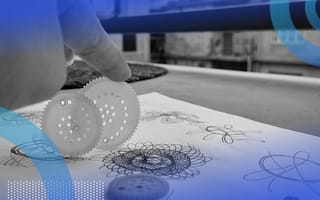Design thinking is a framework for solving complex, human-centered problems. Design thinking encompasses mindsets and tools that help people unleash creative and entrepreneurial behavior.
3 Benefits of Design Thinking
- It enables human-centered design.
- Its prototype and testing phases allow rapid, low-risk and efficient design and iteration.
- It helps unleash creative and entrepreneurial behavior.
The design thinking process unfolds in phases originally proposed by the Hasso-Plattner Institute of Design at Stanford: Empathize, define, ideate, prototype and test.
In the empathize phase, designers learn about the people or users for whom they are innovating. They employ ethnographic-style field research strategies (e.g., naturalistic observation, interviewing) to build empathy for people and understand what is important to them.
In the define phase, teams craft insights about people that highlight their values and needs. Insights are reframed as targeted questions that can be answered through brainstorming in the ideate phase. Once many creative solutions have been generated, convergence techniques are used to narrow down the most promising solutions
In the prototype and test phases, designers build models of their top solutions that are presented to users who interact with them firsthand and provide feedback. Sometimes, mini experiments are run to test the underlying assumptions of a given solution.
Methods of Design Thinkers
Design thinking can nurture a more creative organizational culture because design thinkers embrace mindsets that impact day-to-day interactions and experiences at work.
For example, they are curious, generative, playful, imaginative and observant. They adopt a “test to learn” philosophy and view user testing, experimentation and critical feedback as essential opportunities to learn and grow. They also “build to think,” meaning they spend more time sketching things out on storyboards, building rough prototypes and trying things out.
Design thinkers draw from a library of tools and methods that help them achieve the goals of each phase.
Mapping techniques
In the empathize phase, design thinkers use mapping techniques to help synthesize their learning about users. An empathy map is a graphic organizer that summarizes what users are thinking, feeling and doing in a particular context. The tool surfaces user pain points (frustrations or obstacles in the user experience) and gains (wins, ideal outcomes).
Journey maps are empathy maps plotted over time. Designers identify stages of the end-to-end user experience and capture what people think, feel and do at each stage, along with noting pain points. This allows designers to focus on specific innovation opportunities that arise within the customer journey.
brainstorming tools
In the ideate phase, teams use brainstorming tools to increase their fluency and flexibility. For example, when the well of ideas starts to run dry, the switch-hats technique can be helpful. With this tool, teams generate a list of famous people or brands and then continue the brainstorm by listing ideas that the famous person or company might suggest. This switch of perspective can lead to more ideas and a more diverse range of ideas.
storyboarding
Storyboarding is a method that assists design teams in the very early stages of prototyping. A storyboard is a comic strip depicting how the user will enter, engage with and exit the new experience. Storyboards can be drafted with just a marker on chart paper, or they can be generated digitally, but in all cases, they help designers envision a future state and convey ideas to others. Feedback on a simple storyboard can fuel iteration of solutions before prototypes are built out.
How to Train Your Brain in Design Thinking
The design thinker’s brain must work in ways that run counter to our routine thinking patterns.
Human beings are not naturally inclined to excel at design thinking, and our cognition can interfere with innovation. Certain cognitive efficiencies — such as not encoding details and capturing the gist instead or failing to recognize something in plain view because our attention is directed elsewhere — can serve us well in daily life but serve as obstacles in design thinking.
Here are four ways you can get your brain on board to ensure that your next design sprint is a success.
Observe in teams and take photographs
As our attentional and perceptual systems are bombarded by environmental stimuli, we each attend to different things. When conducting naturalistic observation, work in teams and take photographs so you have a record of the scene that can be studied later.
Engage in bottom-up processing
We tend to draw conclusions about people prematurely based on experience or expectations. Design thinkers who engage in bottom-up processing gather discrete bits of sensory information (quotes, individual observations), record them on individual sticky notes and then identify patterns to ensure that insights are based on new data and not assumptions.
Seek disconfirming evidence
Our thinking is often clouded by confirmation bias, which leads us to notice and lend more credence to information that confirms an existing belief. Designers must acknowledge this bias and actively seek disconfirming evidence to ensure a balanced interpretation of human behavior. Otherwise, our understanding of people may be inaccurate.
Normalize critical feedback
Most people are inherently defensive in the face of critical feedback. For the prototype-test cycles in design thinking to be effective, teams need to create conditions where feedback is viewed as a gift that leads to more innovative solutions.
Sharing ideas “early, ugly and often” can normalize the process of receiving feedback because there is no expectation that early ideas will be perfect. Begin with a round of “what do we love” about this idea before moving into constructive critique.
With its focus on meeting people’s needs and rapid prototyping, design thinking provides a powerful framework for unleashing transformative innovation. Just remember that training for your next design sprint requires leveraging the methods and tools and getting your brain on board, too.





